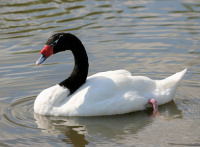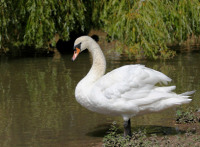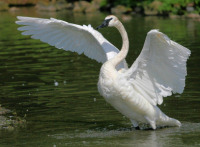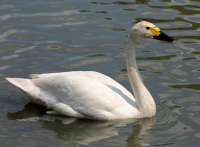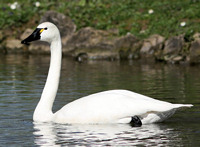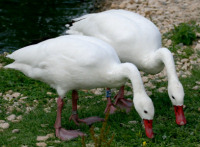There are six to seven species of swan called the Black-necked Swan, Black Swan, Mute Swan, Trumpeter Swan, Tundra swan which includes the Bewick's Swan and Whistling Swan, and the Whooper Swan. The Coscoroba Swan is a distant relation to the Swan and is sometimes linked to the Whistling Duck.
The Black-necked Swan and Black Swan are southern Hemisphere swans with the former found in South America, and the later found in Australia. Northern Hemisphere swans have a pure white plumage.
Swans are amongst the largest flying birds with the Mute Swan being the largest. The male is called a 'Cob', and the female is called a 'Pen', and young swans are called 'Cygnets'. They feed on land and in water and are mostly herbivores eating aquatic plants, roots, and tubers by dabbling or up-ending and using their long neck to reach submerged plants. Swans pair for many years and the female lays 4 to 7 eggs in a nest on the ground near to water. Cygnets can be seen riding on the backs of the parent birds.
What is a 'Swan Song' and what is the origin of this phrase?:
A 'Swan Song' is the final gesture or performance, given before dying or retirement. Its origins are thought to date back to the Romans and states that while they are mute during the rest of their lives, swans sing beautifully and mournfully just before they die. This is however just a myth.
Black-necked Swan: The Black-necked Swan has a white body with a black head and neck, a greyish beak with large red knob near the base of the beak, and a white eye-stripe. Both sexes are similar with the male (Cob) being slightly larger than the female (Pen).
more information.....
Black Swan: The Black Swan has mainly a black plumage with a line of white feathers on the wings, the beak is red with a white bar and tip, the legs, and feet are greyish black. Both the male (Cob), and female (Pen) look similar although the Cob is slightly larger with a straighter beak. Cygnets are a fluffy greyish-brown.
more information.....
Mute Swan: The Mute Swan is one of the largest and heaviest flying birds. They are all white with a slight yellow-orange tinge on top of the head, orange-red beak which has a black tip, the legs and feet are black, and they have a distinctive black knob above the beak which is much larger on the male (Cob) than the slightly smaller female (Pen). The cygnets are grey-brown with grey legs and beak.
more information.....
Trumpeter Swan: The Trumpeter Swan has a white plumage with a black beak marked with salmon-pink along the mouth-line, the black extends from the beak to the front of the eye, the feet are usually a grey-black. The female (Pen) closely resembles the male (Cob) but is slightly smaller. The Trumpeter Swan looks similar to the Whistling Swan (see Tundra Swan) as both are white with a black beak and legs but the Whistling Swan is slightly smaller, has a different shaped beak and usually has a small yellow patch in front of the eye.
more information.....
Bewick's Swan (Tundra Swan): The Bewick's Swan has a white plumage with a black beak marked with salmon-pink along the mouth-line, the black extends from the beak to the front of the eye, the feet are usually a grey-black. The female (Pen) closely resembles the male (Cob) but is slightly smaller. The Trumpeter Swan looks similar to the Whistling Swan (see Tundra Swan) as both are white with a black beak and legs but the Whistling Swan is slightly smaller, has a different shaped beak and usually has a small yellow patch in front of the eye.
more information.....
Whistling Swan (Tundra Swan): The Whistling Swan is similar to the larger Trumpeter Swan and has a white plumage, a black beak with a salmon-pink streak along the mouthline and variable amounts of yellow at the base of the beak which may be lacking, dark-brown eyes, and the legs and feet are black. The female (Pen) is similar to the male (Cob) but is usually slightly smaller.
more information.....
Whooper Swan: The Whooper Swan have a completely white plumage, the beak is yellow with a black tip, and the legs and feet are dark-grey to black. The male (Cob) is similar to the female (Pen) but is usually slightly larger. The Whooper Swan is similar to the Bewick's Swan but has more yellow on its beak and is a slightly larger bird.
more information.....
Coscoroba Swan: The Coscoroba Swan has an all-white plumage except for black wing tips which can be seen when in flight, brown eyes, a bright reddish-pink beak and reddish-pink legs and feet. Both sexes are alike. The body resembles a very small swan, the head looks like a goose, and the beak is similar to a duck.
more information.....

